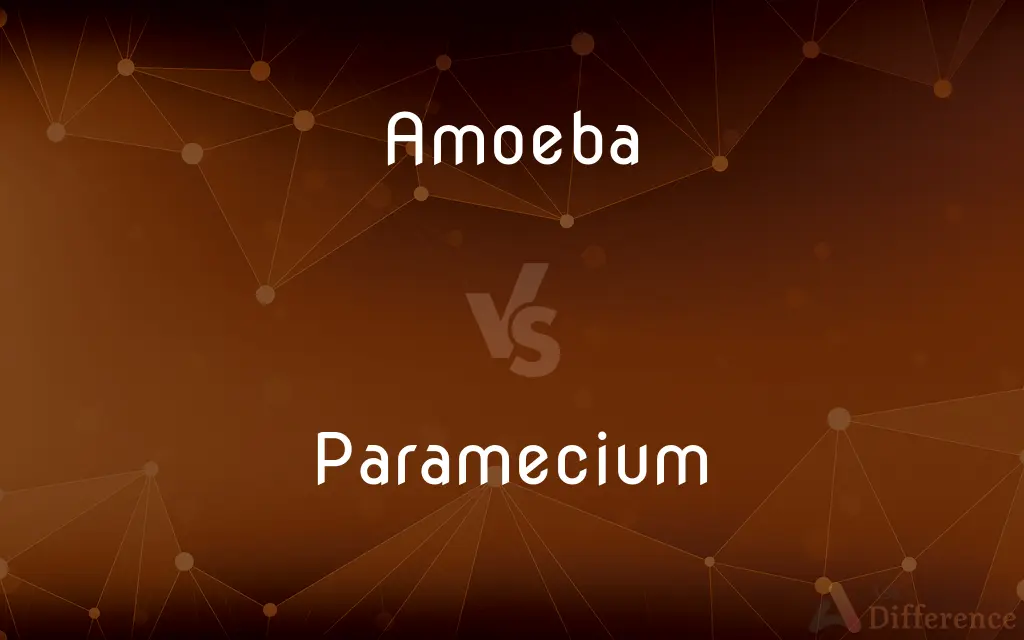Amoeba vs. Paramecium — What's the Difference?
Edited by Tayyaba Rehman — By Urooj Arif — Updated on March 20, 2024
Amoeba and Paramecium are both single-celled, eukaryotic organisms, but they differ significantly in structure, movement, and feeding mechanisms. Amoeba moves and feeds by extending pseudopodia, while Paramecium uses cilia for movement and feeding.

Difference Between Amoeba and Paramecium
Table of Contents
ADVERTISEMENT
Key Differences
Amoeba is known for its shape-shifting abilities, due to its flexible cell membrane and the formation of pseudopodia (false feet) which it uses for locomotion and to engulf food particles through a process known as phagocytosis. Paramecium, on the other hand, has a more fixed, slipper-shaped body with a pellicle that provides some rigidity, and it uses the coordinated movement of cilia (tiny hair-like structures) to move and to direct food into its oral groove.
The feeding mechanism of an amoeba involves surrounding and engulfing food particles, then forming a food vacuole where the food is digested. Paramecium has a more complex feeding process involving an oral groove, where cilia beat to create water currents, drawing food particles into the cell where they are digested in food vacuoles.
Amoeba reproduces asexually through binary fission, where the cell divides into two new cells. Paramecium also primarily reproduces asexually through binary fission, but it can undergo a sexual reproduction process called conjugation, where two Paramecia exchange genetic material to increase genetic diversity.
In terms of habitat, amoebas are typically found in freshwater environments, soil, and even in some parasitic forms. Paramecium is usually found in stagnant bodies of freshwater, where there is an abundance of decaying organic matter to feed on.
Comparison Chart
Movement
Uses pseudopodia for locomotion.
Uses cilia for movement.
ADVERTISEMENT
Feeding
Engulfs food particles through phagocytosis.
Directs food into oral groove using cilia.
Shape
Shape-shifting, no fixed shape.
Fixed, slipper-shaped with some rigidity.
Reproduction
Asexually through binary fission.
Asexually through binary fission; sexually via conjugation.
Habitat
Freshwater, soil, parasitic forms.
Stagnant freshwater bodies.
Compare with Definitions
Amoeba
Shape-shifting organism.
The amoeba constantly changed its shape as it moved.
Paramecium
Slipper-shaped with rigid pellicle.
The Paramecium's slipper shape helped it navigate through water.
Amoeba
Uses pseudopodia for movement.
The amoeba extended its pseudopodia to capture a food particle.
Paramecium
Thrives in stagnant freshwater.
The Paramecium was abundant in the nutrient-rich stagnant pond.
Amoeba
Engulfs food through phagocytosis.
The amoeba engulfed the bacteria, forming a food vacuole.
Paramecium
Feeds using an oral groove.
Food particles were swept into the Paramecium's oral groove by cilia.
Amoeba
Found in various environments.
The amoeba thrived in both the pond water and damp soil.
Paramecium
Undergoes conjugation for sexual reproduction.
The Paramecia exchanged genetic material through conjugation.
Amoeba
Asexually reproduces by binary fission.
The amoeba divided into two cells through binary fission.
Paramecium
Uses cilia for locomotion and feeding.
The Paramecium moved rapidly, propelled by its cilia.
Amoeba
An amoeba (; less commonly spelt ameba or amœba; plural am(o)ebas or am(o)ebae ), often called an amoeboid, is a type of cell or unicellular organism which has the ability to alter its shape, primarily by extending and retracting pseudopods. Amoebae do not form a single taxonomic group; instead, they are found in every major lineage of eukaryotic organisms.
Paramecium
Paramecium (also Paramoecium, , PARR-ə-MEE-sh(ee-)əm, , -see-əm) is a genus of eukaryotic, unicellular ciliates, commonly studied as a representative of the ciliate group. Paramecia are widespread in freshwater, brackish, and marine environments and are often very abundant in stagnant basins and ponds.
Amoeba
Any of various one-celled free-living or parasitic protozoans having no definite form and moving by means of pseudopods.
Paramecium
Any of various slipper-shaped freshwater ciliate protozoans of the genus Paramecium, having an oral groove for feeding.
Amoeba
(biology) A member of the genus Amoeba of unicellular protozoa that moves by means of temporary projections called pseudopodia.
Paramecium
An oval-shaped protozoan organism of the genus Paramecium.
Amoeba
(mathematics) The graph of the real part of the logarithms of a polynomial equation in complex numbers.
Paramecium
Any member of the genus Paramecium
Amoeba
(slang) An asexual.
Amoeba
A rhizopod common in fresh water, capable of undergoing many changes of form at will. Same as ameba. See Rhizopoda.
Amoeba
Naked freshwater or marine or parasitic protozoa that form temporary pseudopods for feeding and locomotion
Common Curiosities
How do amoeba and Paramecium obtain their food?
Amoeba engulfs food particles through phagocytosis, while Paramecium uses cilia to sweep food into its oral groove.
What distinguishes amoeba's movement from Paramecium's?
Amoeba moves by extending pseudopodia, while Paramecium uses coordinated cilia movement.
Can Paramecium change its shape like an amoeba?
No, Paramecium has a more fixed, slipper-shaped body due to its pellicle, unlike the shape-shifting amoeba.
Where can you commonly find amoebas and Paramecia?
Amoebas can be found in freshwater, soil, and as parasites, while Paramecia are commonly found in stagnant freshwater bodies.
What type of reproduction is unique to Paramecium?
Paramecium can engage in a sexual reproduction process called conjugation, unlike amoeba which only reproduces asexually.
How do amoebas and Paramecia adapt to their environment?
Amoebas adapt by changing their shape and engulfing food or particles for protection, while Paramecia use cilia for rapid movement and feeding in their aquatic environment.
How does the feeding mechanism of Paramecium differ from amoeba's?
Paramecium uses cilia to create currents that sweep food into its oral groove, whereas amoeba engulfs food using pseudopodia.
Is it possible for an amoeba to reproduce sexually like Paramecium?
Amoebas primarily reproduce asexually, and sexual reproduction like Paramecium's conjugation is not typical for amoebas.
Are amoebas and Paramecia considered multicellular organisms?
No, both amoebas and Paramecia are single-celled, eukaryotic organisms.
What role do amoebas and Paramecia play in their ecosystems?
Both amoebas and Paramecia are important for nutrient cycling in aquatic ecosystems, serving as both predators and prey in the microbial food web.
Share Your Discovery

Previous Comparison
Document vs. Writing
Next Comparison
Patty vs. HamburgerAuthor Spotlight
Written by
Urooj ArifUrooj is a skilled content writer at Ask Difference, known for her exceptional ability to simplify complex topics into engaging and informative content. With a passion for research and a flair for clear, concise writing, she consistently delivers articles that resonate with our diverse audience.
Edited by
Tayyaba RehmanTayyaba Rehman is a distinguished writer, currently serving as a primary contributor to askdifference.com. As a researcher in semantics and etymology, Tayyaba's passion for the complexity of languages and their distinctions has found a perfect home on the platform. Tayyaba delves into the intricacies of language, distinguishing between commonly confused words and phrases, thereby providing clarity for readers worldwide.















































